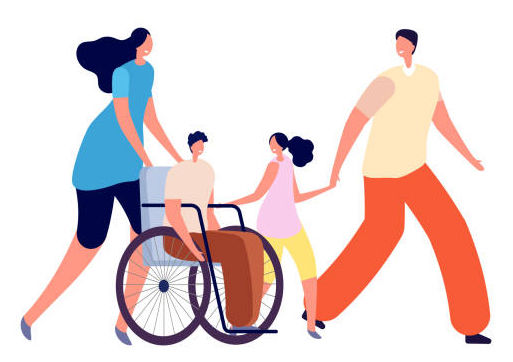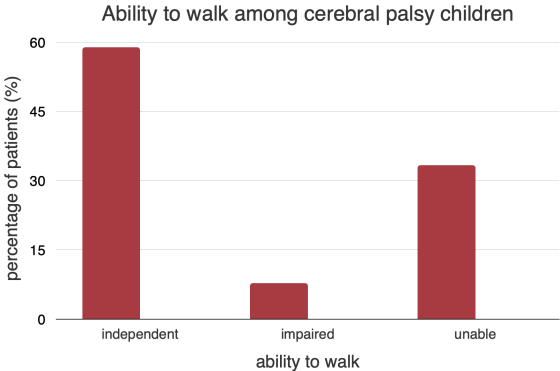Cerebral palsy guide
 What is cerebral palsy?
What is cerebral palsy?
 Cerebral palsy (CP) is a neurological disease caused by damage to the brain that affects movement and coordination. Cerebral palsy is a long-lasting condition that develops before, during, or shortly after birth and is the most common cause of disability in childhood.
Cerebral palsy (CP) is a neurological disease caused by damage to the brain that affects movement and coordination. Cerebral palsy is a long-lasting condition that develops before, during, or shortly after birth and is the most common cause of disability in childhood.
Cerebral palsy affects muscle tone, movement, and coordination. It occurs when the brain cannot properly send messages to the muscles on how to move smoothly and in a coordinated manner. Cerebral palsy can also affect body functions such as breathing, bladder and bowel control, eating, and speech.
The cause of cerebral palsy is undisclosed, but it can be associated with infections during pregnancy, intrauterine or postpartum stroke, genetic disorders, and congenital disabilities.
Following the information from Autism and Developmental Disabilities Monitoring Network, 1 out of 345 children born is diagnosed with cerebral palsy. Also, it is more frequent in boys than in girls. Almost half of the sick youths cannot walk on their own. In addition, approximately 4 out of 10 children with cerebral palsy have comorbidities, such as, for example, epilepsy, and 1 out of 10 have an autism spectrum disorder.
 Diagnostic tests
Diagnostic tests
Cerebral palsy symptoms do not appear immediately after the birth of the baby. Usually, signs become noticeable during the first 2-3 years of a child's life. Symptoms may include:
- developmental delay - for example, not sitting by 8 months or not walking by 1.5 years;
- weakness in the arms or legs;
- fussiness, jerkiness or clumsiness of movements;
- random, uncontrolled movements;
- tiptoe walking;
- swallowing difficulties, speech problems, vision problems, and learning difficulties.
The severity of symptoms can vary greatly. Some people have minor issues. For others, it can cause severe disability.
There is no single or straightforward test for cerebral palsy. Instead, it takes time, numerous tests and observations to make an accurate diagnosis and rule out other conditions. Diagnosis of cerebral palsy consists of several steps:
- developmental monitoring - tracking the growth and development of a child over time.
- developmental screening test - whether the child has inevitable developmental delays, such as motor or movement delays at a certain age. Doctors recommend screening at 9, 18, 24 and 30 months.
- developmental and medical evaluations - diagnosis of a specific type of disorder affecting a child. The test helps assess motor delays, carefully examine the child's motor skills, muscle tone, reflexes and posture, and carefully collect medical history from parents. In addition, the doctor will try to exclude other diseases that can cause similar problems.
Testing for cerebral palsy may include:
- Blood tests - determines the child's general health and exclude other diseases with similar symptoms.
- Motor tests check the child's fine and gross motor skills. Some examples of gross motor skills include balance and walking. Some examples of fine motor skills include holding a spoon and pressing a button.
- Imaging tests of the brain include magnetic resonance imaging (MRI), computed tomography (CT), ultrasound of the skull, or electroencephalogram (EEG), which can reveal seizure activity.
Most kids are usually diagnosed with the disease between the ages of one and three. Early examination is essential because it helps to initiate therapy and prevent complications.
 Treatment methods
Treatment methods
 The condition is not entirely cured. However, existing resources and methods can help kids grow and develop to their maximum potential. As a result, the sooner treatment begins, the more likely children will overcome developmental disabilities or learn new ways of doing complex tasks.
The condition is not entirely cured. However, existing resources and methods can help kids grow and develop to their maximum potential. As a result, the sooner treatment begins, the more likely children will overcome developmental disabilities or learn new ways of doing complex tasks.
There is no standard care that works for every individual with cerebral palsy. Once the diagnosis and type of palsy are established, a team of doctors will work with the child and parents to identify particular impairments and needs and develop an appropriate plan to address the underlying impairments affecting the child's quality of life.
- Drug treatment - first of all, consists of using drugs to relax stiff, contracted or overactive muscles.
- Physiotherapy - usually begins shortly after diagnosis and is the mainstay of treatment for cerebral palsy. Specific exercises can maintain or improve muscle strength, balance, and motor skills. In addition, special braces (orthopaedic devices) may be used to improve mobility and stretch spastic muscles.
- Occupational therapy optimizes upper body functions, improves posture and maximum use of the child's mobility. In addition, it helps to find new ways to satisfy everyday activities: getting dressed, attending school, and participating in daily activities.
- Recreational therapy - encouraging participation in artistic and cultural programs, sports and other activities that help a person develop physical and cognitive skills and abilities.
- Speech and language therapy improves a child's ability to speak more clearly, helps with swallowing problems, and teaches new communication methods.
- Treating eating and drooling problems children with cerebral palsy have difficulty eating and drinking because they have poor control of the muscles that move their mouth, jaw, and tongue. As a result, they are also at risk of inhaling food or liquids into their lungs, malnutrition, recurrent lung disorders, and advanced lung infection.
 New treatments options
New treatments options
Various treatment options can improve symptoms and, by extension, children's quality of life. The doctor can start many interventions immediately after the diagnosis, another part of which can be carried out later.
- Orthopaedic surgery is recommended to eliminate pain symptoms when walking and moving. For many people with cerebral palsy, it is also essential to improve the appearance of the gait. Orthopaedic surgeons can achieve muscle lengthening and tendon correction that are comparatively short. As a result, it improves mobility and reduces pain. Doctors can shift orthopaedic surgery at a time appropriate to the youngster's age and level of motor development. This type of surgery also corrects or significantly improves spinal deformity in people with cerebral palsy.
- Nerve cutting surgery (selective dorsal rhizotomy) is a surgical procedure recommended in cases of severe spasticity when increasingly conservative treatments fail. The surgeon locates and selectively cuts overactive nerves at the base of the spine. This type of surgery is most frequently used to relax muscles and relieve chronic pain in the limbs.
- Stem cell therapy is currently an experimental treatment for cerebral palsy. Stem cells can transform into other types of cells in the body and repair damaged nerves and brain tissue.
As scientists continue to explore new treatments for cerebral palsy and expand our knowledge of brain development, we can expect significant improvements in child care.
 Statistics and prognosis
Statistics and prognosis
Cerebral palsy's life duration depends on the condition's severity and comorbidities. With mild symptoms, life expectancy does not differ from healthy people.
The National Institute of Neurological Disorders and Stroke (NINDS), part of the National Institutes of Health (NIH), are leading sponsor of basic, clinical, and translational research into diseases of the brain and nervous system. Much of what we know about cerebral palsy comes from these studies.
According to studies, 58.9% of sick children could walk independently, 7.8% walked using hand-held devices for movement, and 33.3% had limited ability to walk or did not walk at all.

Life with cerebral palsy is different for every youth. To help your child move and learn as much as possible, let's work closely with the entire AiroMedical team to develop a treatment plan. Then, as the child grows and needs change, we will help to adjust the plan as needed.
References:
- Cerebral Palsy Guide: Living with cerebral palsy
- NHS: Overview - Cerebral palsy
- Cerebral Palsy: Screening and Diagnosis of Cerebral Palsy
- Birth Injury Justice Center: Diagnosing Cerebral Palsy
- National Institutes of Health: Cerebral Palsy: Hope Through Research
- KidsHealth®: Cerebral Palsy (CP)